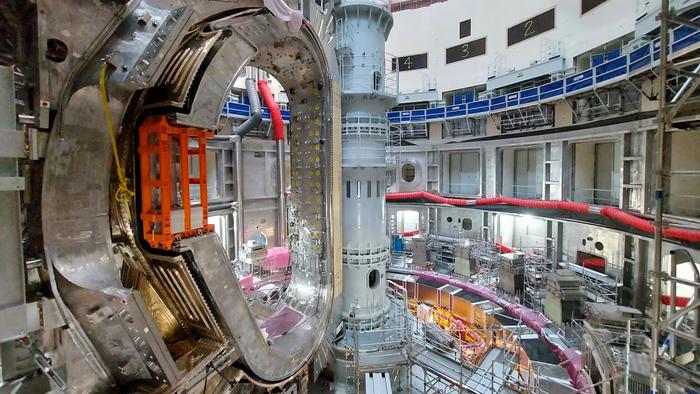As researchers around the world work to develop viable alternatives to fossil fuels, the prospect of nuclear fusion—harnessing the same energy-generating reactions that power the sun—has grown increasingly attractive to private equity firms.

Credit: Eugenio Schuster/Lehigh University
As researchers around the world work to develop viable alternatives to fossil fuels, the prospect of nuclear fusion—harnessing the same energy-generating reactions that power the sun—has grown increasingly attractive to private equity firms.
In 2022, the U.S. Department of Energy launched a partnership with investors in the private sector to accelerate the development of fusion energy, in part through the development of a fusion pilot plant, or FPP, in the United States.
The FPP and ITER—the world’s largest nuclear fusion reactor, currently being built in France—represent the future of fusion, according to Eugenio Schuster, a professor of mechanical engineering and mechanics in Lehigh University’s P.C. Rossin College of Engineering and Applied Science. Ensuring that future is a success, however, requires the reactors to operate within safety, stability, and controllability boundaries, he says.
Schuster, who directs the Lehigh University Plasma Control Group, recently received a $1.6 million grant from the DOE to conduct experiments on the DIII-D National Fusion Facility in San Diego that will ultimately serve to improve the operation of ITER, FPP, and future reactors through the development of advanced controls and the application of machine learning.
The three-year grant is part of a $16 million DOE initiative to fund projects focused on advancing innovative fusion technology and collaborative research on small-scale experiments and on the DIII-D tokamak. The DIII-D tokamak is a device designed not to produce energy, but to help researchers study the physics of the plasma where energy-releasing fusion reactors would take place and develop the technology that is needed for reactor operation.
“There are two goals with this project,” says Schuster. “The first is to improve the operation of DIII-D itself, and the second is to address the technological issues that we’ll be facing with both ITER and FPP.”
Those issues are myriad and exceedingly complex. For one, researchers like Schuster cannot study the type of plasma, called burning plasma, that will be present in fusion reactors.
“In devices like DIII-D, we create a very hot gas in a plasma state, and the goal is to study the physics of that plasma and how to stably confine it,” he says. “But this is not the type of gas that we’re going to use in ITER or in FPP. In fact, the employed gas lowers the probability of fusion in DIII-D instead of increasing it. We don’t want to have nuclear fusion reactions in these experimental devices because then everything becomes radioactive and it becomes much more complicated to carry out experiments.”
Instead, researchers must develop the tools they’ll ultimately need to control the burning plasma of a reactor like ITER or FPP, on a test bed like DIII-D. Using DIII-D, the team will emulate the conditions of an actual nuclear reactor to better understand the dynamics of the plasma and to develop the necessary control solutions. These solutions will ultimately be extrapolated to ITER or FPP by following a model-based approach.
“You have three key elements in the control design,” he says. “One is the control algorithm, or the controller, and that’s what we work on in my group. Based on plasma-response models, we develop algorithms that will keep the plasma dynamics stable and reach the level of performance needed in reactor operation. The other two elements are the actuators, which can modify the dynamics, and the sensors that are your eyes, basically, into what’s happening.”
His team needs to develop algorithms that are smart enough to indicate to the actuators when priorities change. For example, if an actuator is being used to control the temperature of the plasma, but a sudden instability occurs that could cause what Schuster half-jokingly describes as a “poof”—when the hot gas is no longer confined and hits the inner wall of the reactor with all the force of a small earthquake—the algorithm needs to indicate to the plant supervisor that temperature is no longer relevant. The actuator must be repurposed to stabilize the plasma.
“It’s important that the algorithms that we expect to prove on DIII-D can be extrapolated to these other machines,” he says. “They cannot fail. This poof can never happen. The plasma inside ITER and FPP will be 100 million degrees Celsius, and if gas that hot becomes unconfined, it can really damage the reactor. So we have to develop these control algorithms for a machine that cannot fail, but we can’t do any experimentation with that machine.”
He stresses that all the problems inherent in such a challenge won’t be solved within a three-year project. But the work will move the state-of-the-art in incremental yet meaningful steps forward.
Another goal of the project is to bring more researchers into the field of nuclear fusion energy. The workforce necessary for progress hasn’t kept up with the increasing interest in fusion and the nascent nuclear-fusion industry, says Schuster, and the grant will support four PhD students who will all eventually work in San Diego as part of their doctoral program.
“There are several Lehigh graduates who are now a part of the permanent staff at the DIII-D National Fusion Facility,” he says. “A key part of this project is developing the human resources for the next generation of tokamaks that we plan on building.”
He says it’s an exciting time to be in the field. Advances in magnet technology, materials, computational processing, and machine learning—combined with substantial public and private investment—are all bringing the dream of limitless, clean energy a bit closer to reality.
“If I didn’t believe in it, I wouldn’t be working on it,” he says. “I’m feeling optimistic that it will, eventually, happen.”




